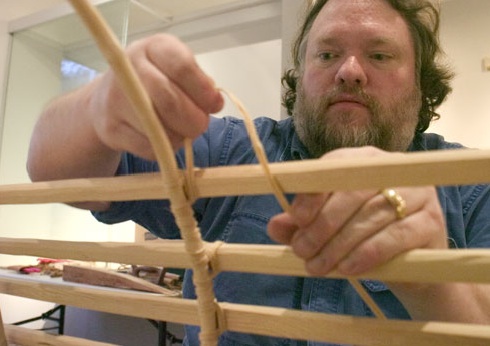In 1989 a nearly complete fish trap was found in Montana Creek, near Juneau Alaska in Aak’w Kwáan Tlingit territory. The cylindrical trap, measuring 3 metres long and 1 metre in diameter, was excavated and found to date to about 600 years ago. The trap was preliminarily reported in Kathryn Bernick’s 1998 book Hidden Dimensions (UBC Press). Fishtraps were supported by wood and/or stone weir structures which also act to direct fish into the trap. The trap would be removed at the end of each season and stored nearby or at camp. Of course, being wood, they intrinsically don’t preserve very well except in anaerobic and wet conditions. They are therefore rather rare since they would need to be left in the creek after use in order to preserve. So this one is very unusual, and especially so since it was essentially complete (other than being flattened). All credit to the finder, Paul Kissner, for being alert, recognizing the trap, and reporting it promptly.
But now, the fishtrap has become very much a living object.

Montana Creek fishtrap on display, after conservation. Trap shape has not been fully restored to cylindrical original. Source: Sealaska.
After extensive conservation (very detailed account here), the trap is now on display at the Juneau Museum. A very informative brochure can be downloaded from the Juneau Library (PDF) describing the trap, and Sealaska Corp. has a very good photo gallery as well.
It is also of interest that a full-scale, detailed replica was made by Steve Henrikson and Jan Criswell using traditional methods and material. This replica is also on display in Juneau. There is a nice slideshow with commentary (autoplays sound) on the construction of the replica.

Detail of Steve Henrikson fastening replica trap components together. Source: Juneau Empire slideshow.
Some of the details of the trap are remarkable and highly informative, I suspect, for the whole Northwest Coast: the multiple details of the means of attachment of the split hemlock ribs/staves to the spruce branch hoops using split spruce root twine is remarkable. Also – the trap is huge, but the entrance is narrow. Montana Creek currently supports Chum, Coho and Pink Salmon, as well as Dolly Varden – the trap may have been selecting for the smaller species.





way cool!
LikeLike
Indeed!
The explorer Sir Alexander Mackenzie was very much impressed when he first saw a trap of similar construction on his journey over the continental divide. (I believe it was on the Parsnip.)
LikeLike
Warning – thread derailer coming up –
These kinds of traps have inspired some great art in the past few years. Here is an example:

With a bit of info about the artist here:
http://www.artltdmag.com/index.php?subaction=showfull&id=1217547632&archive=&start_from=&ucat=32&page=reviews
LikeLike
A very impressive find. It is wonderful to see such a well preserved part of Alaskan Native history. I find the methods of the pre-modern Alaskan Natives to be fascinating and feel that their lifestyles and “green” technology can be a great lesson to those of us, Native and Non-Native both, who chose to live our lives in the Alaskan wilderness in a subsistence manner similar to theirs.
LikeLike
Correction:
Mackenzie found the 15-foot fish trap on the upper reaches of the Fraser.
LikeLike
Hi Roger,
Yes, a cool thing about fishtraps is you can front load the labour and then it sort of works while you aren’t there, overnight, whatever. And you can control so precisely what you catch, what you kill, what you keep. It is ironic they were so quickly banned in the historic period.
Dan — I take it you are referring to Alexander Mackenzie’s journals? He describes some amazingly labour-intensive fish weirs, one of which has both entire trees and gravel in its construction.
LikeLike
Great to see the Montana Creek Trap blogged about. Well done. ZRJ
LikeLike
Hi Zach,
Thanks for stopping by and for the link at your site – I was just composing yesterdays post at the exact time you were leaving comments here which is a bit scary!
LikeLike